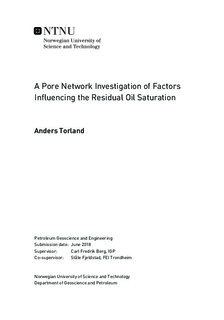| dc.description.abstract | In this thesis a pore network modelling approach is used to investigate the correlation between different pore structure descriptors and the residual oil saturation at the capillary limit. For this study, a range of sandstones, sandpacks and carbonates, including Fontainebleau, Bentheimer and Berea sandstones, were investigated. A suite of scripts were developed in Python to perform simulations and calculate different properties on these network models. The scripts perform a wide variety of tasks, such as potential calculations, streamline and cluster tracking, network manipulation, percolation and plotting.
Primary drainage and waterflooding was simulated at different wetting conditions using the e-Core software to obtain residual oil saturation. Different flow and geometry based pore structure descriptors, such as coordination number, constriction factor, aspect ratio and porosity, were calculated and their correlations with the residual oil saturation at different wetting conditions were compared. The correlation between two different local aspect ratios and the local residual oil saturation was also investigated.
From the obtained results it is evident that the pore structure has a measurable impact on the residual oil saturation. However, the trapping mechanisms are complex, and as the pore structure measures are dependent on each other, it is difficult to find good correlations based on one sole descriptor. The effective porosity yielded the best correlation, which is likely due to the relationship between porosity, aspect ratio and coordination number. The constriction factor, the global aspect ratio and average local aspect ratio exhibit poor correlations with the residual oil saturation. This is partly caused by the carbonates, which deviates from the results obtained from other networks.
A bond percolation process was used to find the bond percolation threshold of the networks studied in this thesis. At the bond percolation threshold, the connectivity through the network is broken and the oil relative permeability is zero. The associated threshold capillary pressure for snap-off exhibited good correlation with the recorded capillary pressure at which the oil relative permeability becomes zero during water flooding. This correspondence indicates that the percolation threshold is the dominating factor for when the oil-phase lose connectivity. The cluster-size distribution of oil after waterflooding was also investigated. However, we did not observe any correlations between the cluster-sizes and the pore structure descriptors. | |

